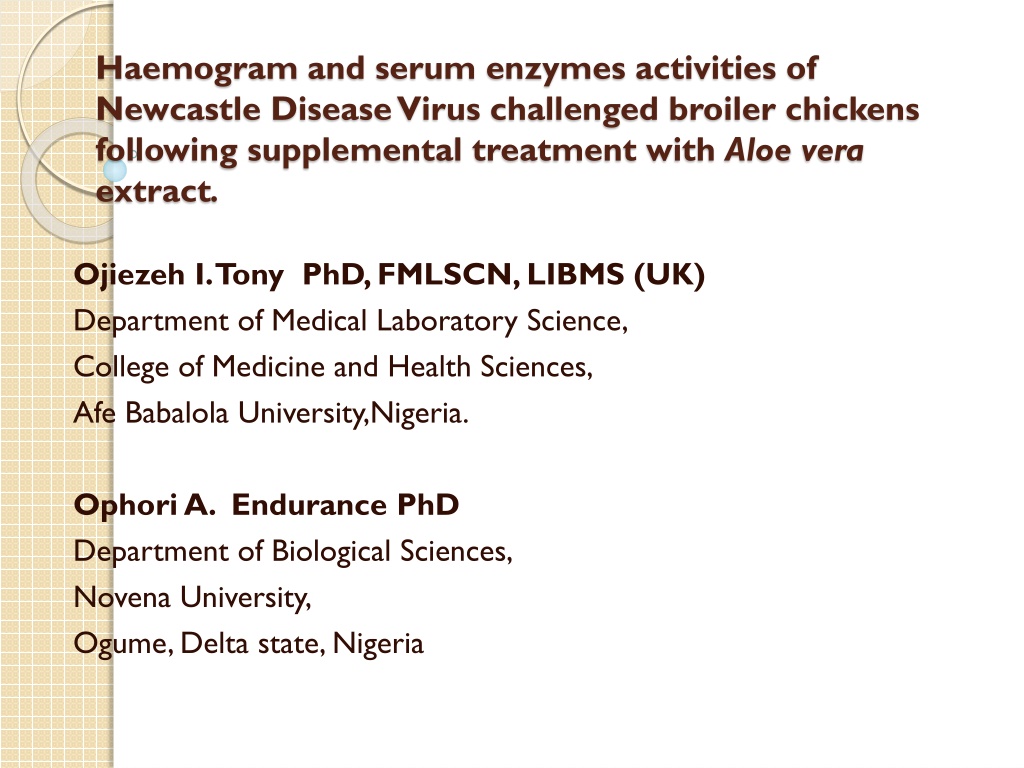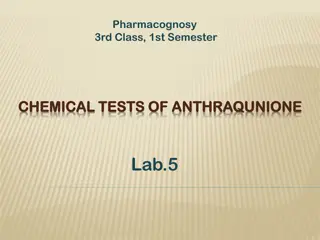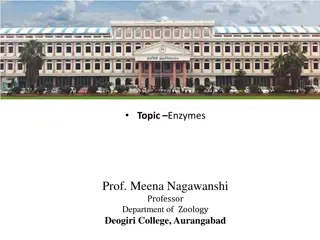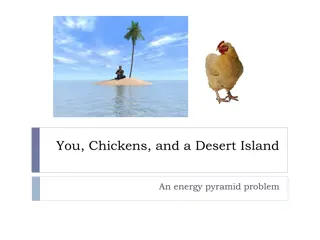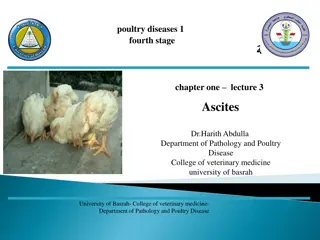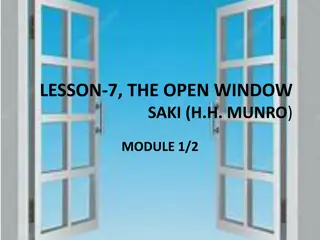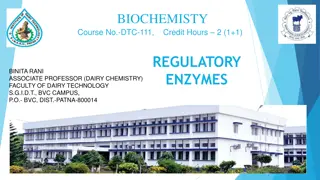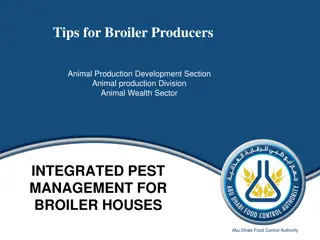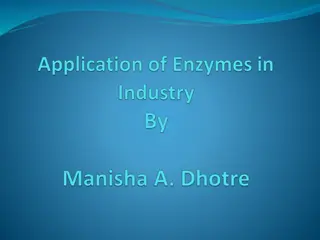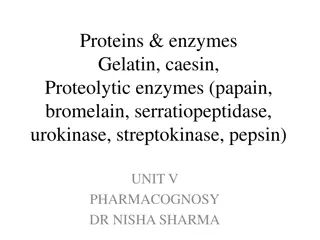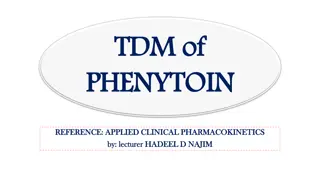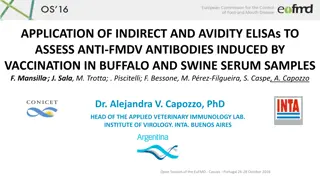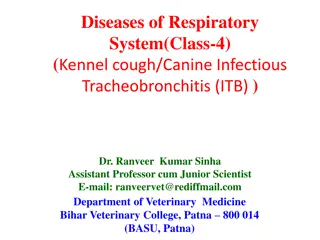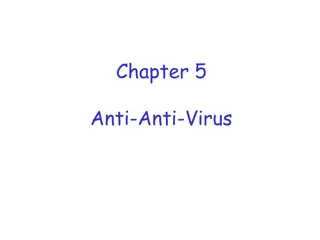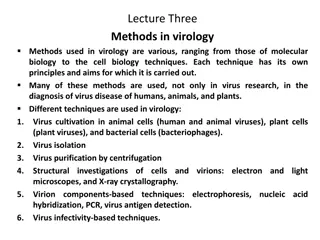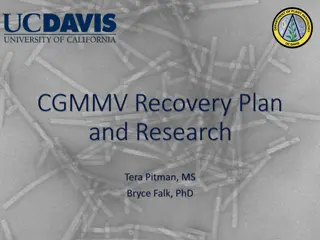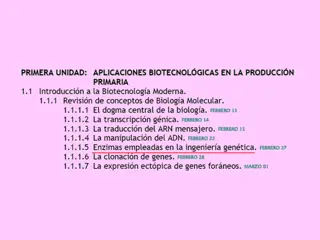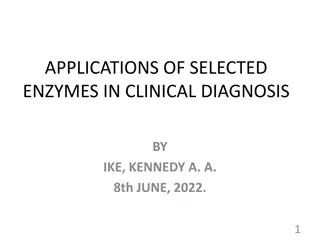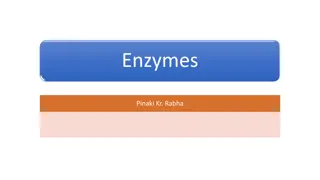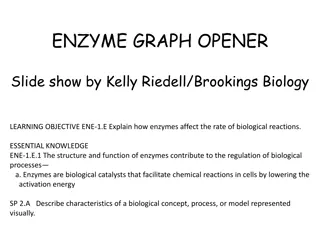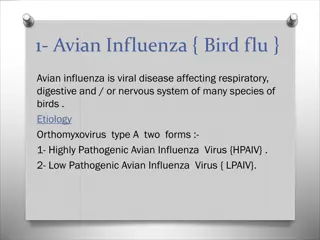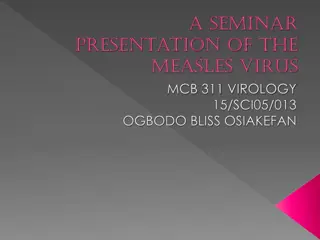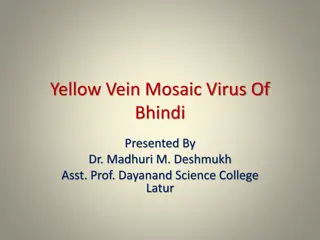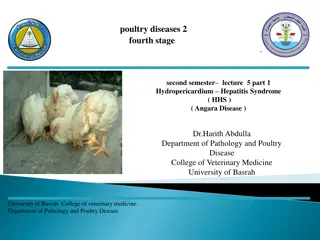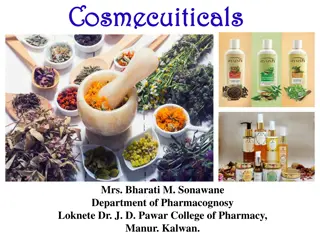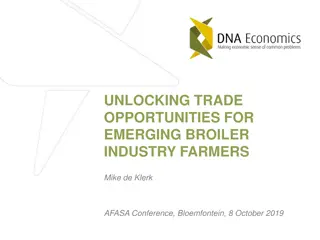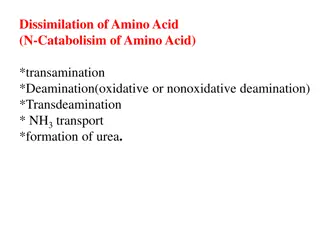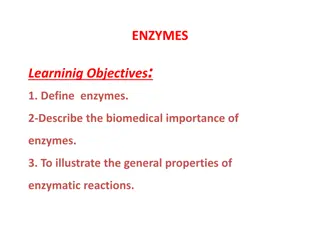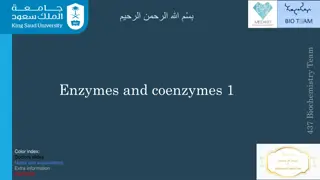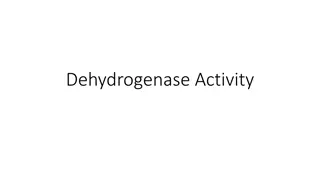Haemogram and Serum Enzymes Activities of Newcastle Disease Virus Challenged Broiler Chickens with Aloe Vera Extract
This study investigates the effects of supplemental treatment with Aloe vera extract on haemogram and serum enzymes activities in broiler chickens challenged with Newcastle Disease Virus. Background information on the use of antioxidants, vitamins, and Aloe vera in traditional and alternative medicine is provided, along with the potential benefits and limitations of Aloe vera products. Results and implications for treating Newcastle Disease Virus in poultry are discussed.
Download Presentation

Please find below an Image/Link to download the presentation.
The content on the website is provided AS IS for your information and personal use only. It may not be sold, licensed, or shared on other websites without obtaining consent from the author. Download presentation by click this link. If you encounter any issues during the download, it is possible that the publisher has removed the file from their server.
E N D
Presentation Transcript
Haemogram and serum enzymes activities of Newcastle Disease Virus challenged broiler chickens following supplemental treatment with Aloe vera extract. Ojiezeh I. Tony PhD, FMLSCN, LIBMS (UK) Department of Medical Laboratory Science, College of Medicine and Health Sciences, Afe Babalola University,Nigeria. OphoriA. Endurance PhD Department of Biological Sciences, Novena University, Ogume, Delta state, Nigeria
Outlines Background Why NDV Clinical signs Objective Materials and methods Laboratory analysis Results Conclusion Acknowledgement References Plates
Background *It has been recommended that most diet be augmented with supplemental antioxidants and vitamins (Hemial,1997).Some of the well studied and most readily available supplements are beta carotene, selenium,vitamin C,vitamin E and vitaminA (Hemial,1997).Populations that have diets high in beta carotene have a lower incidence of certain forms of cancer (Hemial,1997). *Historical use of various Aloe species by humans has been well documented, though the species ofAloe used and their clinical effectiveness remain not fully understood (Reynolds,2003).Of the 300 species ofAloe,only few have been used traditionally in herbal medicine. *Some species,in particular Aloe vera is used in alternative medicines and as a first aid material in some homes. -Both the translucent inner pulp and the resinous yellow exudates are used externally to relieve skin discomforts (Maenthaisong et al.,2007). -Systematic reviews of randomized and controlled clinical trials have provided no evidence that Aloe vera has a strong medicinal effect (Richardson et al., 2005).
Background cont Aloe products for internal use have been promoted for constipation, coughs, wounds, ulcers, diabetes, cancer, headaches, arthritis, immune-system deficiencies, and many other conditions. However, the only substantiated internal use is as a laxative (Grindlay and Reynolds, 1986). Bioactive compounds such as alkaloids, flavonoids, steroids, terpenoids glycosides, carbohydrates and tannins were present in the leaves of Aloe vera (Ejoba, 2012). Aloe vera has been traditionally used as antibacterial, anti- fungal and antiviral agents, immune enhancement, wound healing, anti-inflammatory properties, constipation and for the female reproductive system (Hecht, 1981, Davis and Robson (1999). -There have been some studies in animal models which indicate that extracts of Aloe plant may have a significant anti- hyperglycemic effect, and may be useful in treating Type II diabetes. These studies have not been confirmed in humans (Tanaka et al., 2006).
Why NDV? Description of NDV - Single-stranded RNA virus. Transmission -occurs by exposure to faecal and other excretions Strains - NDV strains can be categorised as velogenic (highly virulent- spread rapidly, and cause up to 90% mortality) mesogenic (intermediate virulence) or lentogenic (nonvirulent) Use as an anticancer agent - Attenuated strain of NDV (MTH-68) showed a promising report in cancer patients. It appears the virus preferentially targets and replicates in certain types of tumor cells, leaving normal cells almost unaffected. Hebrew University reported in 2006 This mechanism of delaying apoptosis in abnormal cells gives NDV the specificity it needs to be an efficient cancer fighting oncolytic virus. History of NDV in cancer therapy - The main advances of viruses in cancer therapy came with the advent of reverse genetics technologies (Flanagan et al. 1955 in Mullen & Tanabe 2002, Vigil et al. 2007. With these new possibilities, studies of modified NDV strains with enhanced cancer treatment properties have been put on the agenda.
Why NDV cont Pros and cons in cancer therapy -NDV possesses many unique anticancer properties and thereby provides an excellent base in virotherapy research. -NDV has selectivity on oncogenic cells, -One of the main issues using NDV treatment is the host/patient immune response against the virus itself, which prior to the time of the reverse genetics technology, decreased the applicability of NDV as a cancer treatment
Clinical signs of NDV Plate 2. chronic stage of NDV infection Plate 4. Infected proventriculous of chicken small intestine Plate 3. Death stage of NDV infection
Objective To determining the heamogram and serum enzymes activities of NDV challenged broilers following supplemental treatment with various concentrations of Aloe vera extract.
Materials and methods Laboratory model: 140-day-old broiler chickens Inoculums A: vial of lyophilized challenged strain of Newcastle disease virus (NDV) was obtained from National Veterinary Research Institute, Vom, Plateau state, Nigeria. A saline suspension of 106 ELD50 was prepared. Aloe vera (AV) extract Aloe vera juice was prepared following the method described by Wu et al. (2006) with slight modification. The AV extract was evaporated to dryness at 37 C using a Speed Vac (Model 7811001, Labconco, USA). The recovered extract was weighed and formulated in distilled water to give the required dose. Treatment of broilers The broilers were housed in battery cages 0.31 m2 / bird as recommended by Mustafa et al. (2010). All experimental protocols complied with NIH guidelines (NRC, 1985), And was approved by the Ethical and Research Committee (ERC), Achievers University, Owo. All the birds received necessary medication and vaccination exempting NDV vaccine with the exception of the NDV vaccinated control group.
Grouping of broilers Grouping of birds: They were distributed into 7 groups of 20 birds each 0. 5 05 Group I were not supplemented with Aloe vera extract i.e 0 mg, Group II were supplemented with 50 mg, Group III were supplemented 100 mg, Group IV were supplemented 150 mg, Group V were supplemented 100 mg but not challenged with NDV (SNC), Group VI were not supplemented and not challenged with NDV (NSNC) & Group VII were vaccinated, not supplemented and not challenged with NDV (VNSNC). Each treatment group was supplemented for 30 days. Birds were then challenged with intramuscular administration of inoculums bearing 0.2 ml of 106 ELD50(50 percent Embryo Lethal Dose) of saline suspension of NDV on the 30th day, and were examined for clinical signs and symptoms, samples were harvested from the wing veins.
Laboratory Analysis Haematological parameters -Pack Cell Volume (PCV), -Haemoglobin (Hb), -Leukocyte (total WBC and differential count) Serum biochemistry Levels of Total protein (TP) Albumin (Ab) Globulin (G) Creatinin (CRK) Gamma glutamyltransaminase ( GT) Alanine aminotransaminase (ALT) Aspartate aminotransaminase (AST) Urea Uric acid and Alkaline phosphate (AKP)
Results Serum biochemistry of Aloe vera supplemented broilers AST and GT (indicative of tissues damage thereby causing leakage of enzymes to the blood stream) CRK indicates some sort of muscle damage; CRK and Urea are insensitive and relatively poor diagnostic test in birds. Transaminases are commonly used indicators of cellular necrosis and increase in serum concentration may indicate liver malfunction. They occupy a central position in amino acid metabolism the concentration of these enzymes in the serum predict the severity of damage. Physiological status such as age, pregnancy and disease conditions of animals and humans will significant influence serum AKP level of patients
Figure 1. Serum Protein, and Albumin activities of NDV challenged broilers following Aloe vera supplementation and control groups Figure 2. Serum Alkalin phosphatase, Gamm globulin Transamerase transamerase activities broilers following Aloe vera supplementation and control groups and NDV Aspatate challenged of Figure 3. Uric acid, urea and CRK of NDV challenged broilers supplementation and control groups following Aloe vera
Heamatological parameters Aloe vera modulated leucocytes proliferation of the supplemented broilers and enhanced the cell differentiation in favour of the lymphocyte as observed in the blood smear. An increasing practice among ornithologists is the use of blood smears to assess immune function of birds by counting the numbers and proportions of white blood cells (leukocytes) on blood smears, a leukocyte profile (or differential count) obtained from the individual patients gives insight into its immune function.
Plate 5: Morphology of Birds red blood cell and leucocytes: L=lymphocytes, H=heterophil, M= monocyte, B=basophil, E=eosinophil, P=platelets and R=red blood cells
Figure 4.. H/L ration of NDV challenged broilers following Aloe vera supplementation and control groups Figure 5 . Hb (g/dl) and PCV (%) of NDV challenged broilers following Aloe vera supplementation and control groups Figure 6. lymphocyte count (%) of NDV challenged broilers following Aloe vera supplementation and control groups
Table 1. Haematological parameters of NDV challenged broilers following Aloe vera supplementation and control groups Treatment groups (mg) > 0mg 50mg 100mg 150mg NSNC SNC VNSNC Total WBC (103/ L) 4.0 0.2 5.4 0.2 1.8 0.1 2.6 0.4 9.4 0.1 21.0 0.1 6.6 0.0 + + + Plasma cell - - - - P < 0.05 (significant at 0.05), Mean SEM Key: NSNC = not supplemented not challenged, SNC = Supplemented but not challenged, NSC= Not supplemented but challenged, VNSNC =NDV Vaccinated not supplemented not challenged
There was a decrease in H / L ratio in the entire challenged birds; this may not be unconnected to the harmful effect of the virus on the birds. The finding of plasma cells on the blood smears of broiler chickens supplemented and challenged group suggest that the extracts may have enhanced the immunity of the birds. Increases in activated B-cells differentiating into plasma cells will yield more antibody.
Summary Oral supplementation of aloe extract regulated immune system as H/L ration was seen to decrease in challenged birds. A. vera extract affected haematopioses of the poultry birds in favour of lymphocytes. This information should be added to the list of other vegetables/herbs tonics that enhances blood formation. The plasma cells suggest that the extract enhanced humoral responses in the supplemented birds and perhaps, it may be used as adjuvant. Serum enzymes activities in broiler chickens challenged with NDV following supplementation with A. vera juice were influenced by the extract, it modulated the excessive leakage of protein, globulin, creatinine and alkaline phosphatase enzymes in affected birds.
Acknowledgement The authors wish to acknowledge Mr. H. B. Fatuade, Heamatology Unit, Federal Medical Centre Owo Mr.O. Odewusi, Medical Laboratory Science Department, Afe Babalola University for technical supports. Dr. Pius Okiki, Consultant Veterinary Doctor for his expertise in handling of the birds and Dr. Tony Joanis of NIVR, Vom for trusting us with the virus.
References Alabi, M. O., Adejumo, D. O., Aderemi, F. A., Lawal, T. E., Oguntunji, A. O., Ayoola, M. O., and Alabi, B. O. (2008). Physiological responses of broiler chickens to oral supplementation with Telferia occidentalis leaf extract at finisher phase. Proceedings of the 13th Annual Conference of the Animal Science Association of Nigeria, Sept. 15-19, ABU, Zaria. 114 - 117. Essien, A. Aletor, V. A. and Fetuga, B. L. (1985). Effect of raw lima bean (phaseolus luntus) diets on intestinal alpha amylase (EC3.2.1) activity in growing rats. Journal of Animal Production and Research 5: 23 - 30. AOAC. (1980). Official methods of analysis of the association of official analytical chemists.11th Edition Washington D.C, U.S.A. 595pp. Davis, P. H. and Robson, M. C. (1999). Anti-inflammatory and wound healing of growth substances in Aloe vera. Journal of American Pediatric and Medical Association84:77 81. Davis, A.K., Cook, K.C. and Altizer, S.(2004). Leukocyte profiles in wild House Finches with an without mycoplasmal conjunctivitis, a recently emerged bacterial disease. EcoHealth 1, 362 373. Emenalom, O. O., Esonu, B. O., Etuk, E. B. and Anaba, C. (2009). Effect of Mucuna pruriens (Velvet Bean) leaf meal on performance and blood composition of finisher broiler chickens. Nigerian Journal of Animal Production36 (1): 52 - 60. Ernst, E., Pittler, M. H. and Stevinson, C. (2002). Complementary/alternative medicine in dermatology: evidence- assessed efficacy of two diseases and two treatments. American Journal of Clinical Dermatology 5:341 - 348. Federico, C. and Manlio, F. (1997). Human B Cell Populations (Chemical Immunology) (v.67). S. Karger AG (Switzerland). 104pp. Fudge, A. M. (2000). Avian complete blood count In: Laboratory Medicine Avian and Exotic Pets.
Plate 7: Tony Ojiezeh administering the extract to the broiler chickens in the cages
Plate 9: Seven week old broiler chickens in cages before NDV challenegd
Plate 9: Three days after NDV challenged of broiler chickens in cage
Thank You
